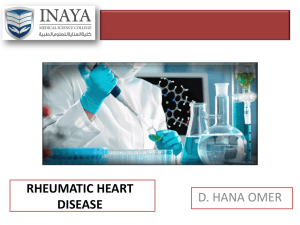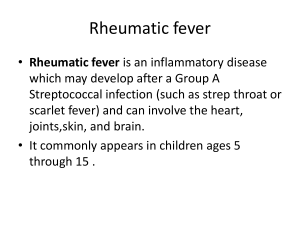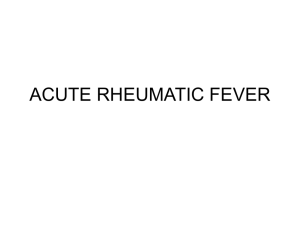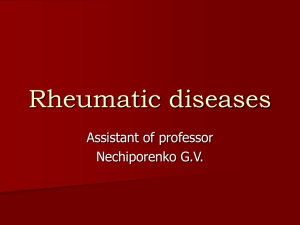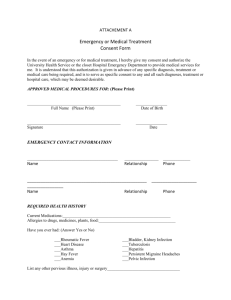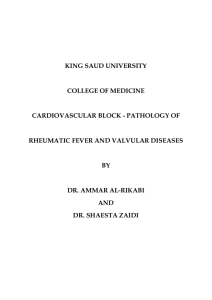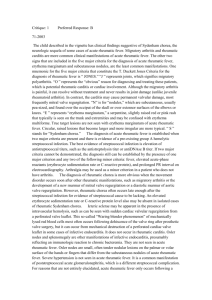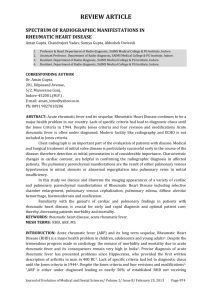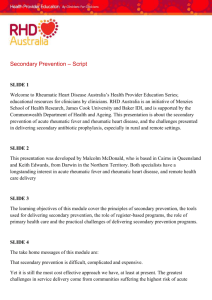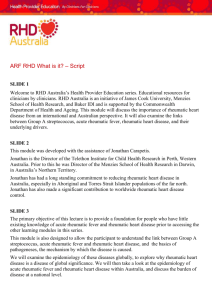Rheumatic fever is a post-streptococcal immune-mediated
advertisement
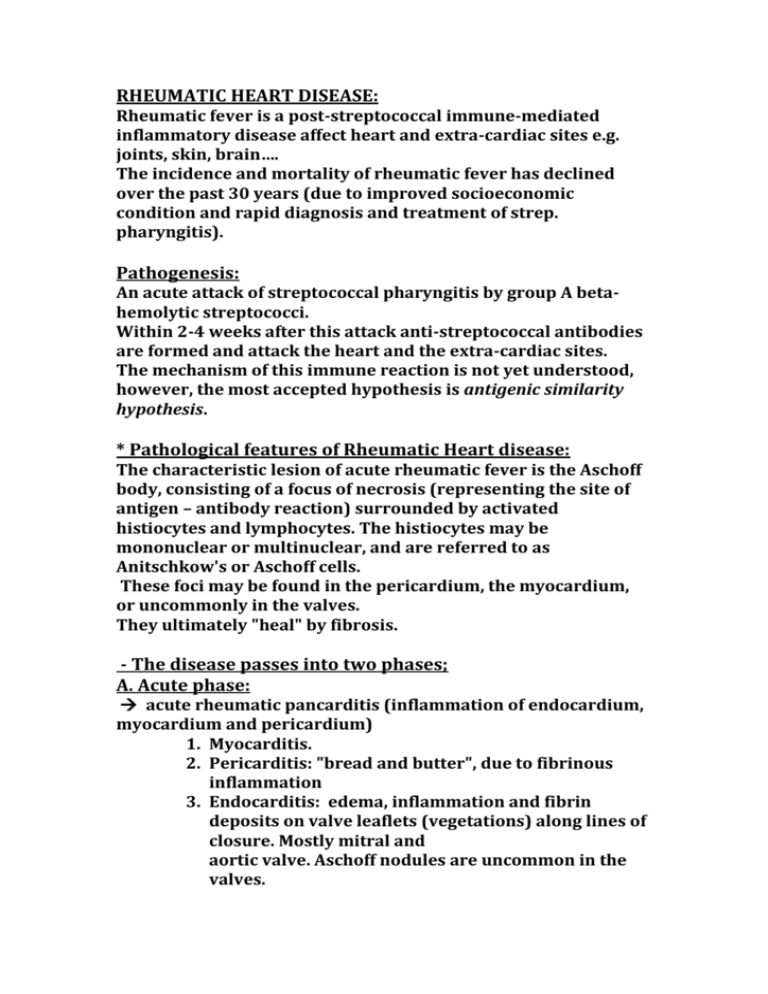
RHEUMATIC HEART DISEASE: Rheumatic fever is a post-streptococcal immune-mediated inflammatory disease affect heart and extra-cardiac sites e.g. joints, skin, brain…. The incidence and mortality of rheumatic fever has declined over the past 30 years (due to improved socioeconomic condition and rapid diagnosis and treatment of strep. pharyngitis). Pathogenesis: An acute attack of streptococcal pharyngitis by group A betahemolytic streptococci. Within 2-4 weeks after this attack anti-streptococcal antibodies are formed and attack the heart and the extra-cardiac sites. The mechanism of this immune reaction is not yet understood, however, the most accepted hypothesis is antigenic similarity hypothesis. * Pathological features of Rheumatic Heart disease: The characteristic lesion of acute rheumatic fever is the Aschoff body, consisting of a focus of necrosis (representing the site of antigen – antibody reaction) surrounded by activated histiocytes and lymphocytes. The histiocytes may be mononuclear or multinuclear, and are referred to as Anitschkow's or Aschoff cells. These foci may be found in the pericardium, the myocardium, or uncommonly in the valves. They ultimately "heal" by fibrosis. - The disease passes into two phases; A. Acute phase: acute rheumatic pancarditis (inflammation of endocardium, myocardium and pericardium) 1. Myocarditis. 2. Pericarditis: "bread and butter", due to fibrinous inflammation 3. Endocarditis: edema, inflammation and fibrin deposits on valve leaflets (vegetations) along lines of closure. Mostly mitral and aortic valve. Aschoff nodules are uncommon in the valves. B. Chronic phase: Acute changes may resolve completely or progress to scarring and development of chronic valvular deformities many years after the acute disease. * Extra-cardiac lesions of rheumatic fever: These lesions are acute and resolve completely without disability. 1. Migratory polyarthritis: It causes "fleeting arthritis" in the large joints, self limited, no chronic deformities. 2. Skin: skin rheumatic nodules, erythema marginatum. 3. Sydenham chorea: a neurologic disorder with involuntary purposeless, rapid movements. * Clinical features of Acute Rheumatic Fever: • Occurs 10 days to 6 weeks after pharyngitis • Peak incidence: 5-15 years. • Cardiac manifestations: pericardial friction rubs, weak heart sounds, tachycardia and arrhythmias. • Extra-cardiac: fever, migratory polyarthritis of large joints, arthralgia, skin lesions, chorea. • Pharyngeal culture may be negative, but anti streptolysin O (ASO) titer will be high. * Jones criteria: A. Major criteria: – – – – – Carditis. Polyarthritis Sydenham’s chorea. Erythema marginatum. Subcutaneous nodules. B. Minor criteria: Previous history of rheumatic fever. Arthralgia. Fever. Lab tests indicative of inflammation : ESR (erythrocyte sedimentation rate), CRP (C-Reactive protein), leukocytosis. – ECG changes. – * Diagnosis of rheumatic fever: • Need 2 major criteria or 1 major and 2 minor criteria. – – – – • CHRONIC RHEUMATIC HEART DISEASE : - Endocarditis heals by progressive fibrosis. Chronic scarring of the valves constitutes the most important long-term sequelae of rheumatic fever, and usually becomes clinically manifest decades after the acute process. • Left sided valves (mitral and aortic) are more commonly involved than the right. • Fibrosis of valve leaflets --> stenosis. • Fibrosis of chordae tendonae --> regurgitation (improper closure). • Other cardiac complications: • Subacute bacterial endocarditis. • Arrhythmia. • Chronic heart failure. • In valve stenosis: Leaflets are thickened, fibrotic, shrunken with fusion Dilatation and hypertrophy of left atrium (atrial fibrillation). secondary deposition of Ca++ fish mouth (button hole) stenosis - i.e. the stenosed valve looks like a fish's mouth Lungs are firm and heavy (chronic passive congestion). Pulmonary hypertension Right side of the heart may be affected later (right ventricular hypertrophy). • In valve incompetence (regurgitation): Retracted leaflets. Left ventricular hypertrophy and dilatation. * Mitral valve stenosis: • Leads to left atrial dilatation and failure, chronic venous congestion of the lung, lung fibrosis, pulmonary hypertension and chronic right sided heart failure. * Mitral valve incompetence: • Leads to left ventricular dilatation and failure, left atrial dilatation and failure, chronic pulmonary congestion, lung fibrosis, pulmonary hypertension and chronic right sided heart failure. Nonbacterial..Thrombotic..Endocarditis NBTE • Characterized by the deposition of small masses of fibrin, platelets, and other blood components on the leaflets of the cardiac valves. There is no infective organism (sterile). • Aortic valve is most common site. • Clinically: asymptomatic, if large: may embolize. * Pathogenesis/ association: – Subtle endothelial abnormalities. – Hypercoagulability. – Association with malignancy (50%). Verrucous (Libman-Sacks) endocarditis • Less common, non-infective endocarditis attributable to elevated levels of circulating immune complexes may occur in patients with systemic lupus erythematosus

